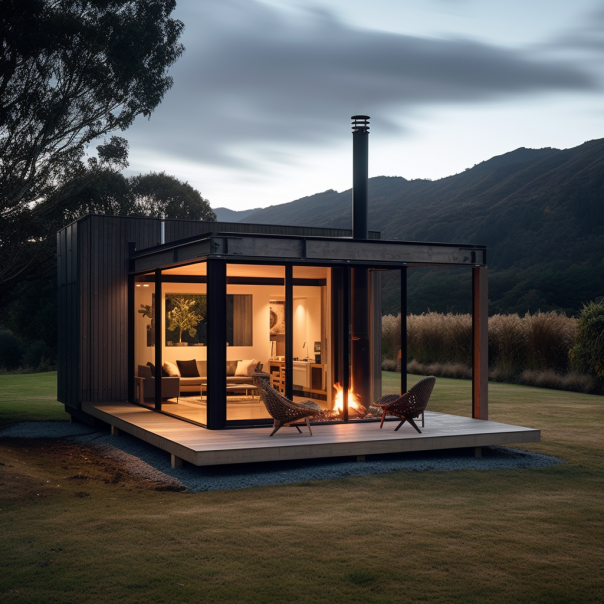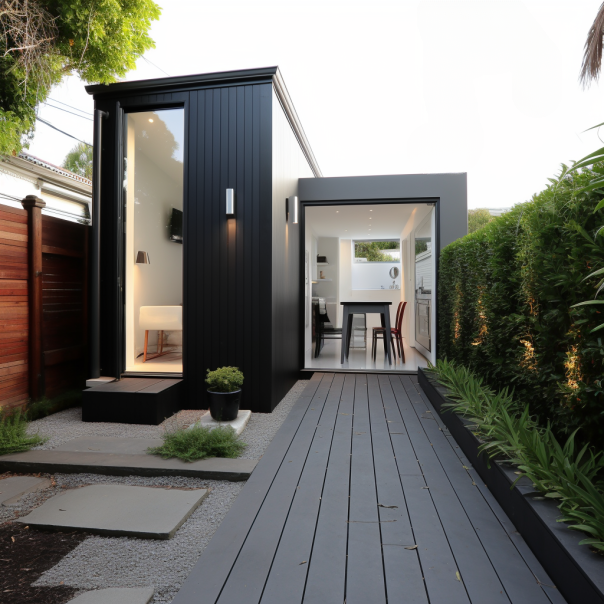All About Minor Dwellings in Auckland
What is a Minor Dwelling?
In Auckland, minor dwellings have always played a role in providing for housing. Simply put, a minor dwelling is a second house that you can build on your property. Its size should not exceed 65m2, not including garages and decks. There are other requirements too, which can vary by zone.
Minor dwellings are a great solution to housing needs in Auckland. They let homeowners make the most of their property space. You can use them to house family members, rent out, or even as a home office.
Zoning and Its Impact on Minor Dwellings
When planning to build a minor dwelling, it's important to understand the rules. The Auckland Unitary Plan (AUP) sets out these requirements.
The Auckland Unitary Plan and Minor Dwellings
The AUP gives homeowners flexibility when adding a second minor dwelling. Before, people could only get approval for one minor dwelling. Larger second dwellings were usually not allowed unless you had a really big site.
The AUP has changed things for homeowners with large properties in popular suburbs.
In certain zones like Residential - Mixed Housing Suburban and Residential - Mixed Housing Urban, you can have up to three dwellings per site. Because of this, minor dwellings are no longer provided for as an activity in most Auckland residential zones.
We suggest that if you meet the requirements for a second dwelling alone, this is what you should go for.
But if you really want to build a dedicated minor dwelling, or 'granny flat', you can apply for a resource consent for one in the zones above. This will be assessed as a non-complying activity. You will need to have a strong argument as to why you need one versus a normal dwelling - see later in this guide for some example use cases for minor dwellings.
Minor dwellings are still allowed as a permitted activity in a few residential zones, where second and third dwellings are not allowed:
· Residential - Single House Zone
· Residential - Rural and Coastal Settlement Zone
· Residential - Large Lot Zone
These minor dwellings must not exceed a floor area of 65m2 excluding decks and garaging, must have outdoor living space, and can only be one per site. They must also meet all other zone requirements including height, yards, coverages etc.
They are also allowed as a permitted activity in the following rural zones:
· Rural - Waitākere Foothills Zone
· Rural - Waitākere Ranges Zone
In all other rural zones, minor dwellings are a restricted discretionary activity, and require resource consent.
There are additional criteria for minor dwellings in the rural zones than residential.
In addition to the 65m2 requirement and yard, coverage and height standards, the additional requirements include the site having a minimum size, a maximum level of reflectivity (The Waitākere Foothills and Waitākere Ranges Zones) and must share the same driveway access as the principal dwelling.
If a minor dwelling does not meet any of the requirements including size, it will require resource consent, and the council will carefully check whether it is in fact a second dwelling.
Principal Dwellings vs Minor Dwellings
The AUP differentiates between principal dwellings and minor dwellings.
A principal dwelling is the main house on a property, while a minor dwelling is smaller and supplementary.
Minor dwellings are limited to 65m2, excluding garaging and decks. Principal dwellings usually have no size limit.
Sleep-outs vs Minor Dwellings
Minor dwellings and sleep-outs are different.
A sleep-out, for instance, would not usually contain a kitchen.
So, even though a sleep-out might provide some similar uses like extra sleeping or living space, it does not qualify as a minor dwelling under the Auckland Unitary Plan.
But this is not necessarily bad – because it is instead treated as an accessory building, which has fewer requirements under the Auckland Unitary Plan, besides standard bulk, location and coverage standards.
The difference between a minor dwelling and a sleep-out might be the deciding factor on whether a resource consent is required.
Subdivision Around a Minor Dwelling
Subdivision is dividing a piece of land into two or more smaller lots. It can be a good way to maximise the value of your property.
However, subdivision is generally not possible with minor dwellings.
Under the AUP, subdivision of a minor dwelling away from the principal dwelling must be on a new lot that meets the minimum site size requirement for subdivision in the applicable zone.
For example, in the Residential - Single House Zone, this will generally be 600m2 net site area. A lot size smaller than this is a prohibited activity, which means it cannot even be applied for.
If you have a large piece of land that could already be subdivided into two lots – for example, a 1,200m2 site in the Residential - Single House Zone – then a subdivision of the minor dwelling from the principal dwelling is enabled as a restricted discretionary activity.
In the Residential - Mixed Housing Suburban and Residential - Mixed Housing Urban Zones, you may find instances where a minor dwelling has been consented under an old plan. The restriction on subdivision still applies.
For these, the council practice is to require two applications, one that first converts the minor dwelling into a second principal dwelling, and then a second application to propose a subdivision. This is a bit of a convoluted process that requires more time and consent cost but could be worth it in terms of the value unlocked for the land.
Remember, subdivision in Auckland and elsewhere can be complex process that involves a range of surveying and planning considerations. It's always best to seek professional advice before going down this path.
Building a Minor Dwelling: Auckland Council Guidance and Consent Requirements
Auckland Council have published official guidance on minor dwellings, in the form of a practice and guidance note. This guide is more aimed at planners preparing applications but is useful additional reading if you want to learn more.
In some cases, you may not need a building or resource consent for your minor unit. The Land Transport Act (LTA), Building Act, and Resource Management Act (RMA) via the AUP all play a role in determining this.
For instance, if your structure is a "light simple trailer," you might not need a building consent. However, if the structure is meant to be a permanent, immovable residence equipped with a bathroom or kitchen, you will likely require one.
Keep in mind, a resource consent may still be required either way. This is because in Auckland, a minor dwelling is classed as a ‘use’ of land, and whether it occupies a structure is immaterial. It will depend on the zone and whether the size and location of the minor dwelling meets any of the standards that apply.
Even if your structure is less than 65m2, meets all other standards, and is in an appropriate zone that provides for a minor dwelling as a permitted activity, there may still be situations where you'll need a resource consent.
Getting Professional Help and Quality Assurance
When considering constructing a minor dwelling in Auckland, one of the most crucial aspects to consider is the importance of engaging trained, licensed building practitioners. This is not only integral to ensuring that your project is completed to the highest standard, but it also ensures you are complying with local regulations and building codes.
Licensed building practitioners bring an array of benefits to a construction project. They have the technical skills needed to ensure the project is done correctly and efficiently.
This expertise extends to understanding the complexities of building codes and regulations, which can be a minefield for the untrained individual.
Costs and Potential Risks
The cost of constructing a minor dwelling in Auckland is influenced by a wide array of factors such as council consents, materials used, labour costs, site assessments and service connections.
According to Refresh Renovations, considering all these elements, the building cost generally starts from around $200,000.
While this might seem like a considerable investment, it is important to weigh it against the potential benefits.
A minor dwelling can provide an additional income stream if rented out, add value to your property, or provide a comfortable living area for family members.
In many cases, the benefits outweigh the initial costs, making minor dwellings an attractive option for many homeowners.
While the idea of doing it yourself or employing a less-qualified person to undertake your minor dwelling project might seem appealing from a cost-perspective, it's important to understand the potential risks associated with this approach. Errors in construction can lead to serious structural problems, endangering the safety of those who use the dwelling. Additionally, failure to comply with the Building Act could result in hefty fines, or even the forced demolition of the structure.
Use Cases for Minor Dwellings
Minor dwellings offer a unique flexibility with regards to their usage.
As secondary houses on your existing property, these small units can serve a variety of purposes, transforming the way you utilise your residential space.
One of the most common uses of minor dwellings is as home offices.
With the rise of remote work, having a quiet, dedicated workspace away from the hustle and bustle of the main house can significantly increase productivity. A minor dwelling provides an ideal setting for such a set-up, offering a serene environment for focused work, along with the facilities you need like a small kitchen setup, and bathroom.
Beyond workspaces, minor dwellings also make great guest rooms. If you frequently host family or friends, a minor dwelling gives your guests privacy and comfort. They’ll have their own space without feeling like they’re intruding on yours.
Finally, these compact spaces can also be transformed into creative studios. Whether you’re a musician needing a soundproof room, an artist seeking solitude for your craft, or a writer looking for a peaceful corner, a minor dwelling could be the perfect solution.
Frequently Asked Questions
What is a minor dwelling?
A minor dwelling is a secondary, smaller house that you can build on your property. In Auckland, New Zealand, its size should generally not exceed 65m2, not including garages and decks. Minor dwellings are often used to house family members, serve as rental units, or act as holiday accommodation.
What are the rules for minor dwelling in New Zealand?
The rules for minor dwellings can vary by location. In Auckland, the requirements are set out in the Auckland Unitary Plan (AUP). For instance, in Residential - Mixed Housing Suburban and Residential - Mixed Housing Urban zones, you can have up to three dwellings per site, and don’t need to distinguish any as a minor dwelling. In other zones where only one dwelling per site are allowed, minor dwellings are separately provided for either as a permitted or restricted discretionary activity. However, there are specific requirements they must meet, such as not exceeding a floor area of 65m2 and having an outdoor living space.
Can I put a minor dwelling on my property in NZ?
Yes, you can generally put a minor dwelling on your property in New Zealand, but the specific rules and requirements may vary depending on the zone your property is in. It is important to check the requirements outlined in the relevant district plan. You should also consult with a planning consultancy to understand the specifics of any rules that may apply.
Do I need consent to build a minor dwelling?
Whether you need consent to build a minor dwelling depends on various factors including the zone your property is in, the size and location of your minor dwelling, and other requirements. In some cases, if your structure meets certain criteria, you might not need a building consent. However, a resource consent may still be required.
How much does a minor dwelling cost in NZ?
The cost of constructing a minor dwelling in Auckland, New Zealand, can be influenced by several factors such as council consents, materials used, labour costs, site assessments and service connections. The building cost generally starts from around $200,000.
Summing Up
Minor dwellings are a great solution for many homeowners in Auckland. They can be used in many different ways and can greatly increase the value and functionality of your property. It's important to understand the rules and regulations around them, and to seek professional help when needed. By doing so, you can make the most of your property and create a space that truly meets your needs.



